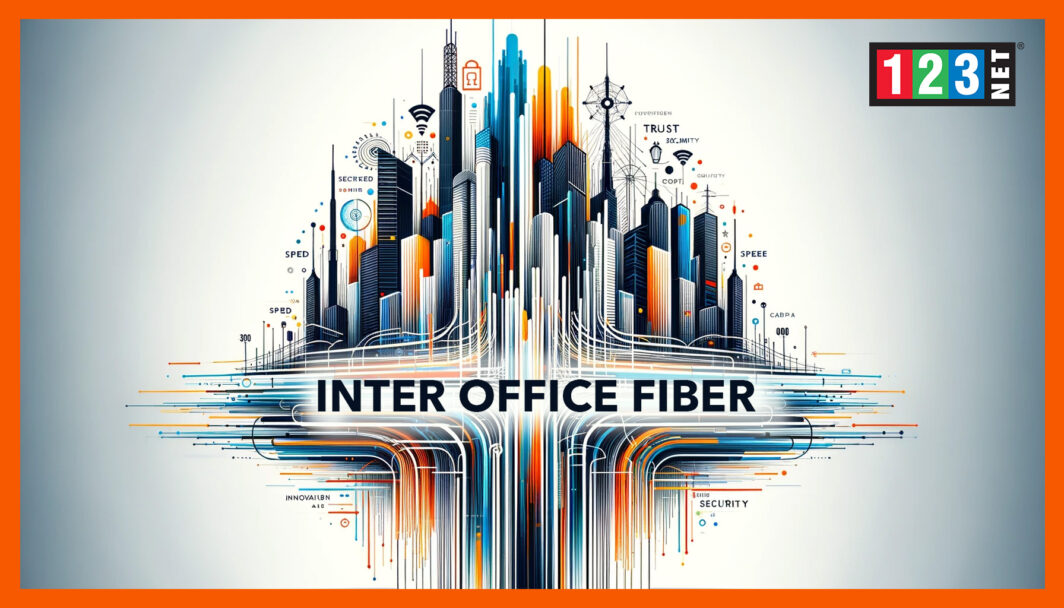
Introduction
In the modern landscape, a major shift is starting. We’re moving from old methods to advanced fiber optics. This technology stands out for its speed, reliability, and security. Inter office fiber is key in this evolution. This technology also ensures greater reliability and security in communications. It explains why fiber optics are changing communication networks in organizations. This transition is changing how we think about internet. Fiber optics bring a new era of efficiency and performance. They explain the standards for moving information. It delves into how fiber optics transform networks. With these insights, we can appreciate the importance of this technology. It’s clear that fiber optics are crucial for modern communications.
Understanding Fiber Optic Technology
At the core of fiber optic technology is the optical fiber. This slender strand transmits data lightning-fast, at light speed. Made of glass or plastic, optical fibers carry light pulses across vast distances. These pulses encode data in binary, forming the basis of our high-speed internet and data transmission that’s essential in today’s telecommunications.
Fiber optic cables, which are bundles of these optical fibers, act as the critical infrastructure’s spine. Wrapped in protective layers, they’re shielded from electromagnetic interference. This protection ensures a pristine signal and enhanced data security, a stark contrast to the older copper cables.
The association between fiber optic technology and high-speed internet is well-founded. It supports gigabit speeds, dwarfing traditional broadband capabilities. This makes it perfectly suited for the heavy data demands of modern office settings. With its unparalleled speed and reliability, fiber optics enable the streaming of high-definition content, smooth video conferencing, and efficient cloud computing.
Moreover, fiber optic technology’s resilience against external disruptions positions it as a reliable choice for critical communications. Its low latency improves real-time applications, making digital interactions nearly instantaneous. The environmental advantages are notable too, as fiber optics consume less energy and offer a greener alternative to metal-based cables.
Advantages of Inter Office Fiber
Inter office fiber revolutionizes connectivity with its superior bandwidth and reduced latency. This upgrade translates to quicker cloud access, smoother video calls, and efficient data backups. Such improvements boost office productivity and foster better collaboration.
Bandwidth and Latency
With higher bandwidth, teams experience less buffering during crucial meetings. Access to cloud platforms becomes almost instantaneous, vital for modern workflows. This swift and reliable connection supports the seamless exchange of large files, enhancing work efficiency.
Latency, or the delay before a transfer of data begins following an instruction for its transfer, is noticeably lower with fiber optics. This reduction is crucial for real-time applications like video conferencing, where even a slight lag can disrupt communication. Lower latency ensures that interactions are as close to real-time as possible, essential for maintaining the flow of discussion and decision-making in remote or hybrid work environments.
Scalability and Network Reliability
Fiber optic networks excel in scalability and reliability. They easily accommodate growth, making them a future-proof choice for expanding businesses. Their reliability surpasses traditional methods, offering stable connections with minimal downtime. This stability is key in maintaining uninterrupted operations, particularly for services reliant on constant online presence.
Network reliability is further enhanced by fiber’s resistance to signal loss over long distances. Unlike copper cables, fiber optic cables maintain signal strength, ensuring consistent connectivity across extensive office spaces or between different locations. This reliability supports the demands of high-traffic networks, crucial for large organizations or those with heavy data usage.
Secure Network and Data Security
Security is paramount in the digital realm, and fiber optic networks offer superior protection. Their technology makes data breaches more challenging for cybercriminals, safeguarding sensitive information. This enhanced security is invaluable for businesses handling confidential data, providing peace of mind in an era of increasing cyber threats.
The secure nature of fiber optics stems from its immunity to electromagnetic interference and eavesdropping. Traditional cables can leak information, but fiber optics transmit data as light, making unauthorized access vastly more difficult. This security aspect is critical for financial institutions, healthcare providers, and any organization prioritizing data privacy.

Types of Fiber Optic Installations
FTTH (Fiber to the Home)
FTTH, or Fiber to the Home, is crucial for businesses in small offices or homes. This method brings fiber optic cables right to the premises, delivering unmatched speed and reliability. It’s ideal for operations demanding high bandwidth and minimal latency, ensuring smooth and efficient digital workflows.
This direct fiber connection supports heavy data tasks like high-definition video streaming, large file transfers, and real-time cloud computing without a hitch. It’s a game-changer for remote work environments, where dependable internet is essential for productivity and collaboration.
FTTC (Fiber to the Curb)
FTTC (Fiber to the Curb) and FTTN (Fiber to the Node) offer a hybrid solution. Here, fiber optics reach a nearby point, and copper cables complete the connection. Although not as fast as FTTH, these setups significantly outperform traditional broadband, providing a noticeable boost in internet speed and reliability.
These configurations are cost-effective alternatives for areas where direct fiber to each home or office is not feasible. They strike a balance between improved performance and the practicalities of infrastructure deployment, making faster internet accessible to more users.
Fiber Optic Installation
Installing fiber optics is a meticulous process, requiring strategic planning and skilled execution. Whether laying cables underground or stringing them overhead, each step must be carefully managed. This includes ensuring the network’s compatibility with existing hardware and the seamless integration into the office’s digital infrastructure.
The transition to fiber optic internet, regardless of the specific configuration, represents a significant upgrade over older technologies. It brings the promise of faster, more reliable internet connections, paving the way for innovations in how businesses operate and how professionals connect and collaborate. For companies looking to future-proof their operations and maximize their digital potential, investing in fiber optic technology is a strategic move toward achieving those goals.
The Role of Internet Service Providers for Inter Office Fiber
ISPs (Internet Service Providers)
ISPs are pivotal in delivering fiber optic connectivity. They handle the network’s installation, maintenance, and upgrades. This ensures businesses enjoy reliable, fast internet. Their role is essential for modern digital demands, supporting the backbone of today’s internet infrastructure.
Offering a variety of connectivity solutions, ISPs cater to business needs. These services, based on fiber optic technology, offer scalability, security, and speed. Such capabilities are crucial for efficient inter office communication, enabling businesses to thrive in a digital landscape.
Connectivity Solutions
These fiber-based solutions support an array of digital activities. From cloud computing to high-volume data transfers, ISPs make it possible. Their efforts ensure that businesses can leverage the full potential of the digital era, fostering growth and innovation.
Moreover, ISPs are at the forefront of technological advancements. They continuously improve their services to offer the latest in connectivity. This commitment to advancement means businesses can always access cutting-edge internet services.
In summary, ISPs play a key role in the digital economy. They provide the infrastructure and services necessary for businesses to connect and communicate effectively. Through their fiber optic solutions, ISPs enable high-speed, reliable, and secure internet access, which is indispensable for modern business operations.
Challenges and Considerations of Inter Office Fiber
Network Infrastructure
Upgrading to fiber optic cables presents challenges, particularly for businesses with existing networks. The initial expense and installation disruptions are major factors. These considerations weigh heavily on decision-makers, balancing cost against long-term benefits.
Despite these hurdles, the advantages of fiber optics are undeniable. They offer a leap in data transmission speeds and reliability. This technology transforms the capabilities of a business’s digital infrastructure, supporting future growth and technological advancements.
Signal Attenuation and Data Transmission
Fiber optics are less susceptible to signal attenuation compared to copper cables. However, installation quality and coverage distance play critical roles in performance. Ensuring the network is properly installed and maintained is essential for optimal operation.
Investing in skilled technicians for the installation and upkeep of fiber optic cables is crucial. This ensures the network’s longevity and reliability, safeguarding the investment in this technology. Such expertise minimizes potential issues, ensuring businesses fully benefit from the upgrade. For businesses aiming to stay competitive in the digital age, adopting fiber optic infrastructure is a strategic move toward achieving enhanced connectivity and operational efficiency.
Future of Inter Office Fiber
Technology Evolution: The future of inter office fiber looks promising, with ongoing advancements in fiber optic technology expected to further enhance telecommunications. Innovations in optical fiber materials and data encoding techniques will continue to push the boundaries of speed and reliability.
Scalability and Network Infrastructure: As businesses grow and their data needs evolve, the scalability of fiber optic networks will become increasingly important. Future developments are likely to focus on making fiber optic technology more accessible and cost-effective for businesses of all sizes.

Conclusion
Inter office fiber, powered by fiber optic technology, represents a significant leap forward in telecommunications for businesses. Offering internet, superior data transmission capabilities, and enhanced security, fiber optic cables are setting a new standard for network infrastructure. As technology evolves, the adoption of fiber optic solutions is becoming a critical consideration for businesses aiming to stay competitive in the digital era.




